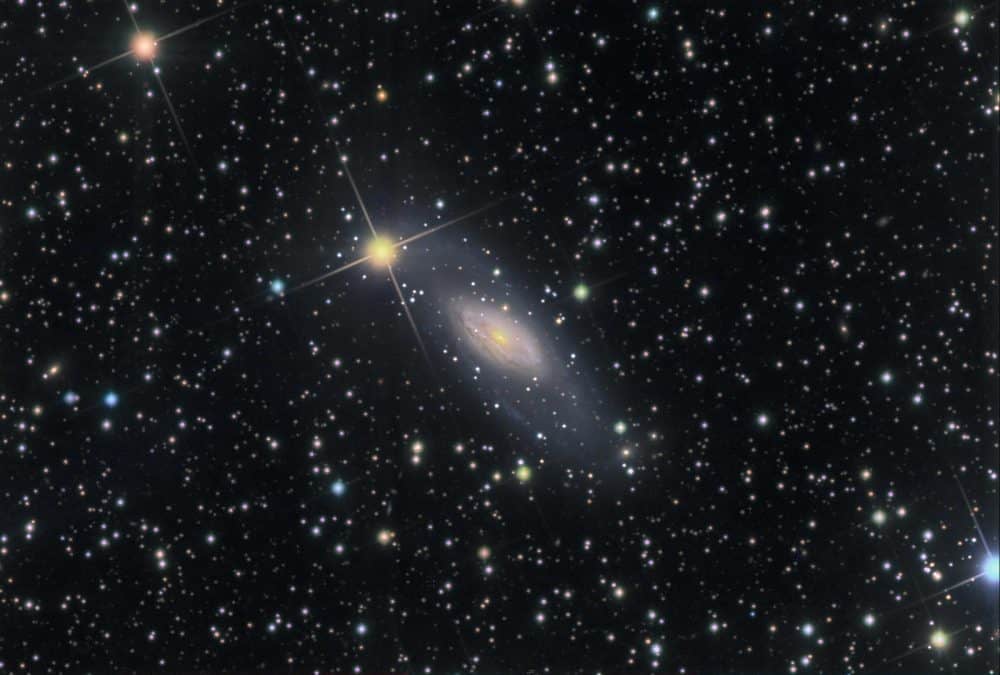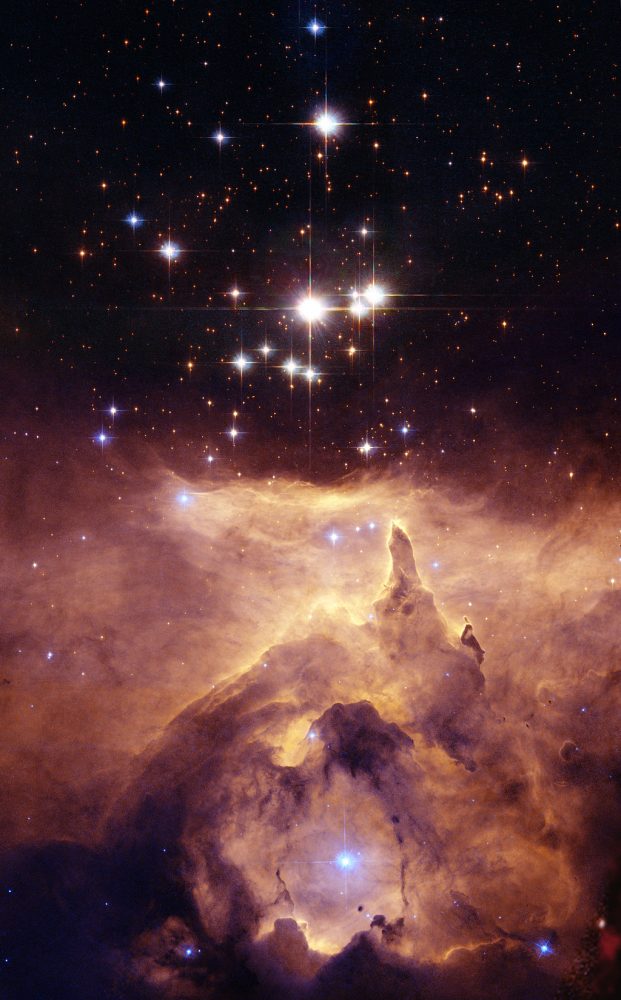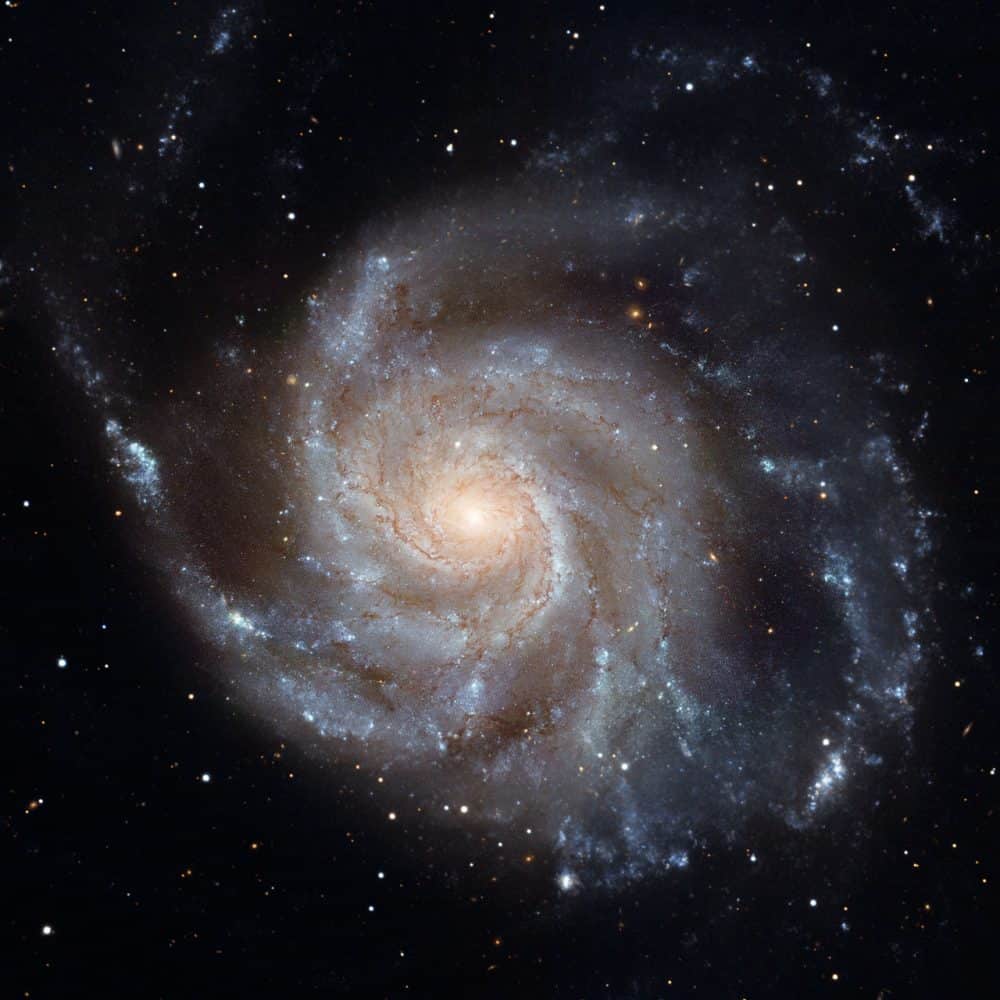Blog
World Music on Flamenco Fridays with Tangos y Bulerias
Antonio Fernández Díaz known as Fosforito, is a flamenco singer and winner of the fifth Golden Key of flamenco singing. Only five of these have been awarded since the award’s inception in 1862. Its previous winners were Tomás “El Nitri,” Manuel Vallejo, Antonio Mairena, and Camarón de la Isla.
more...
https://www.youtube.com/watch?v=8vRGFU7XS_k
more...NGC 7013 is another spiral galaxy. It is tilted slightly toward us so that we can see the galaxy “arms”, however, the classification of this galaxy puts it into either a restricted spiral class or lenticular class. The arms in the inner ring appear to completely disconnect from the center (hence ring), while the outer stars appear to have very little arm pattern (hence lenticular). However in this recent image, more of the arms and connections to the interior “ring” are slightly evident. The bright yellowish star may look like its in one of the arms, but it is in our own galaxy. It is in fact about 25 times fainter than the faintest star you can see at night and while it looks large its size is over a million million times smaller than the more distance galaxy. Below is an original image I took of this galaxy with the C-11. The stats for this galaxy are RA: 21h 03m 33.5s, Dec: +29° 53′ 50″, Mag: 12.4 (B), Size: 4.4’x1.4′, and Class: SA(r)0/a.
NGC 7013 is a relatively nearby spiral or lenticular galaxy estimated to be around 37 to 41.4 million light-years away from Earth in the constellation of Cygnus. NGC 7013 was discovered by English astronomer William Herschel on July 17, 1784 and was also observed by his son, astronomer John Herschel on September 15, 1828.
more...Miroslav Ladislav Vitouš (born 6 December 1947) is a Czech jazz bassist who has had an extensive career in the US.
Born in Prague, he began the violin at age six, and started playing the piano at age ten, and bass at fourteen. As a young man in Europe, Vitouš was a competitive swimmer. One of his early music groups was the Junior Trio with his brother Alan on drums and fellow Czech luminary-to-be Jan Hammer on keyboards. He studied music at the Prague Conservatory (under František Pošta), subsequently winning an international music contest in Vienna, earning him a scholarship to the Berklee College of Music in Boston, Massachusetts, USA.
In 1967, in Chicago, Miles Davis saw Vitous playing with Clark Terry and invited him to join his group for a residency at New York’s The Village Gate.
Vitouš’s virtuoso jazz bass playing has led critics to place him in the same league as Scott LaFaro, Dave Holland, Niels-Henning Ørsted Pedersenand Arild Andersen. A representative example of Vitouš’s double bass playing is Now He Sings, Now He Sobs (1968), with Chick Corea on piano and Roy Haynes on drums. This album shows his strong rhythmic sense, innovative walking lines, and intensity and abandon as an improviser.
more...Eddie Gladden (December 6, 1937 in Newark, New Jersey – September 30, 2003) was an American jazz drummer.
Gladden played professionally from 1962 in his hometown of Newark. In 1972 he began working with James Moody, and subsequently spent time performing and/or recording with Eddie Jefferson, Richie Cole, Cecil Payne, Horace Silver, David Fathead Newman, Larry Young, Freddie Roach, Jimmy McGriff, Richard “Groove” Holmes, Kirk Lightsey, Clifford Jordan, Albert Dailey, Jimmy Ponder, Shirley Scott, and Mickey Tucker, among others. He played in Dexter Gordon‘s quartet from 1977, touring and recording with him copiously.
https://www.youtube.com/watch?v=bkTet5Yd3Kk&t=38s
more...William John Evans (August 16, 1929 – September 15, 1980), best known as Bill Evans, was an American jazz pianist and composer who mostly played in jazz trios.Evans’s use of impressionist harmony, inventive interpretation of traditional jazz repertoire, block chords, and trademark rhythmically independent, “singing” melodic lines continue to influence jazz pianists today.
Born in Plainfield, New Jersey, in 1929, he was classically trained, and studied at Southeastern Louisiana University and the Mannes School of Music, where he majored in composition and received the Artist Diploma. In 1955, he moved to New York City, where he worked with bandleader and theorist George Russell. In 1958, Evans joined Miles Davis‘s sextet, where he was to have a profound influence. In 1959, the band, then immersed in modal jazz, recorded Kind of Blue, the best-selling jazz album of all time. During that time, Evans was also playing with Chet Baker for the album Chet.
In late 1959, Evans left the Miles Davis band and began his career as a leader, with bassist Scott LaFaro and drummer Paul Motian, a group now regarded as a seminal modern jazz trio. In 1961, ten days after finishing an engagement at the New York Village Vanguard jazz club (where the highly acclaimed Sunday at the Village Vanguard and Waltz for Debby albums were recorded) LaFaro died in a car accident. After months of seclusion, Evans re-emerged with a new trio, featuring bassist Chuck Israels.
In 1963, Evans recorded Conversations with Myself, an innovative solo album using the unconventional (in jazz solo recordings) technique of overdubbing over himself. In 1966, he met bassist Eddie Gómez, with whom he would work for eleven years. Many successful albums followed, in trio, duo, and solo settings, such as Bill Evans at the Montreux Jazz Festival, Alone, and The Bill Evans Album, among others.
Many of Evans’s compositions, such as “Waltz for Debby“, have become standards, played and recorded by many artists. Evans was honored with 31 Grammy nominations and seven awards, and was inducted into the Down Beat Jazz Hall of Fame.
Evans grew up in North Plainfield, New Jersey, the son of Harry and Mary Evans (née Soroka). His father was of Welsh descent and ran a golf course; his mother was of Carpatho-Rusyn ancestry and descended from a family of coal miners.
more...The star cluster Pismis 24 lies in the core of the large emission nebula NGC 6357 that extends one degree on the sky in the direction of the Scorpius constellation. Part of the nebula is ionised by the youngest (bluest) heavy stars in Pismis 24. The intense ultraviolet radiation from the blazing stars heats the gas surrounding the cluster and creates a bubble in NGC 6357. The presence of these surrounding gas clouds makes probing into the region even harder.
NGC 6357 is a diffuse nebula near NGC 6334 in the constellation Scorpius. The nebula contains many proto-stars shielded by dark disks of gas, and young stars wrapped in expanding “cocoons” or expanding gases surrounding these small stars. It is also known as the Lobster Nebula.
This nebula was also given the name War and Peace Nebula by the Midcourse Space Experiment scientists because of its appearance. They said that in infrared images the bright, western part resembles a dove, while the eastern part looks like a skull.
It is located about 5500 light years away from Earth
more...Egberto Amin Gismonti (born December 5, 1947 in Carmo, state of Rio de Janeiro) is a Brazilian composer, guitarist and pianist.
Gismonti was born in the small city of Carmo, state of Rio de Janeiro, Brazil, into a musical family. His mother was from Sicily and his father was from Beirut, Lebanon. At the age of six, he started studying the piano at the Brazilian Conservatory of Music. After studying the classical repertoire in Brazil for fifteen years, he went to Paris to delve into modern music. He studied with Nadia Boulanger (1887–1979), after acceptance as a student by the composer Jean Barraqué, a student of Anton Webern and Schoenberg. Boulanger encouraged Gismonti to write the collective Brazilian experience into his music.
more...
Art Davis (December 5, 1934 – July 29, 2007) was a double-bassist, known for his work with Thelonious Monk, John Coltrane, Dizzy Gillespie, McCoy Tyner and Max Roach.
Davis was born in Harrisburg, Pennsylvania, where he began studying the piano at the age of five, switched to tuba, and finally to bass while attending high school. He studied at Juilliard and Manhattan School of Music but graduated from Hunter College.
As a New York session musician, he recorded with many pop acts and also in symphony orchestras such as the Los Angeles Philharmonic. Art Davis was a professor at Orange Coast College.
Davis is also known for starting a legal case that led to blind auditions for orchestras.
Davis earned a Ph.D. in clinical psychology from New York University in 1982. He moved in 1986 to southern California, where he balanced his teaching and practicing of psychology with jazz performances.
more...Richard Wayne Penniman (born December 5, 1932), known as Little Richard, is an American recording artist, singer-songwriter and actor.
A pop music and culture icon, Little Richard’s most-celebrated work dates from the mid-1950s when his dynamic music and charismatic showmanship presaged the rise of rock and roll. His music influenced many other popular music genres, including soul, funk and hip hop and shaped generations of rhythm and blues artists.
Little Richard has been honored by many institutions. He was inducted into the Rock and Roll Hall of Fame as part of its first group of inductees in 1986. He was also inducted into the Songwriters Hall of Fame. He is the recipient of a Lifetime Achievement Award from the Recording Academy and a Lifetime Achievement Award from the Rhythm and Blues Foundation. Little Richard’s “Tutti Frutti” (1955) was included in the National Recording Registry of the Library of Congress in 2010, which stated that his “unique vocalizing over the irresistible beat announced a new era in music.” In 2015, the National Museum of African American Music[1] honored Little Richard with a Rhapsody & Rhythm Award for his role in the formation of popular music genres and in helping shatter racial divisions in the music industry.
Little Richard was born Richard Wayne Penniman on December 5, 1932, in Macon, Georgia. He was the third of twelve children of Leva Mae (née Stewart) and Charles “Bud” Penniman. His father was a church deacon who sold bootlegged moonshine on the side and owned a nightclub, the Tip In Inn. His mother was a member of Macon’s New Hope Baptist Church.
more...The Pinwheel Galaxy (also known as Messier 101, M101 or NGC 5457) is a face-on spiral galaxydistanced 21 million light-years (six megaparsecs) away from Earth in the constellation Ursa Major. First discovered by Pierre Méchain on March 27, 1781, it was communicated to Charles Messier who verified its position for inclusion in the Messier Catalogue as one of its final entries.
On February 28, 2006, NASA and the European Space Agency released a very detailed image of the Pinwheel Galaxy, which was the largest and most detailed image of a galaxy by Hubble Space Telescope at the time. The image was composed of 51 individual exposures, plus some extra ground-based photos.
On August 24, 2011, a Type Ia supernova, SN 2011fe, was discovered in M101.
more...Cassandra Wilson (born December 4, 1955) is an American jazz musician, vocalist, songwriter, and producer from Jackson, Mississippi. Described by critic Gary Giddins as “a singer blessed with an unmistakable timbre and attack [who has] expanded the playing field” by incorporating blues, country, and folk music into her work, Wilson has won two Grammy Awards.
Cassandra Wilson is the third and youngest child of Herman Fowlkes, Jr., a guitarist, bassist, and music teacher; and Mary McDaniel, an elementary school teacher who earned her PhD in education. Her ancestry includes Fon, Yoruba, Irish and Welsh. Between her mother’s love for Motown and her father’s dedication to jazz, Wilson’s parents sparked her early interest in music.
more...Denis Charles (December 4, 1933 – March 26, 1998) was a jazz drummer.
Charles was born in St. Croix, Virgin Islands, and first played bongos at age seven with local ensembles in the Virgin Islands. In 1945 he moved to New York, and gigged frequently around town. In 1954 he began working with Cecil Taylor, and the pair collaborated through 1958. Following this he played with Steve Lacy, Gil Evans, and Jimmy Giuffre. He befriended Ed Blackwell, and the two influenced each other.
He recorded with Sonny Rollins on a calypso-tinged set, and then returned to time with Lacy, with whom he played until 1964. He worked with Archie Shepp and Don Cherry in 1967 and then disappeared from the record until 1971. In the 1970s and 1980s he played regularly on the New York jazz scene with Frank Lowe, David Murray, Charles Tyler, Billy Bang, and others, and also played funk, rock, and traditional Caribbean music. He released three discs as a leader between 1989-1992, and died in New York City in 1998.
Denis Charles died four days after a five-week European tour with the Borgmann/Morris/Charles (BMC) Trio, with Wilber Morris and Thomas Borgmann. His last concert with this trio took place at the Berlin Willy-Brandt-Haus. With the BMC Trio he recorded in his last two years about four CDs. The fifth CD was released after he died: The Last Concert – Dankeschön, Silkheart Records, 1999.
more...James Stanley Hall (December 4, 1930 – December 10, 2013) was an American jazz guitarist, composer and arranger. Premier Guitarmagazine stated that “It could be argued that the jazz guitar tree is rooted in four names: Django [Reinhardt], Charlie [Christian], Wes[Montgomery], and Jim [Hall]”.
Born in Buffalo, New York, before moving to Cleveland, Ohio, Hall was from a musical family, his mother played the piano, his grandfather violin, and his uncle guitar. He began playing the guitar at age ten when his mother gave him an instrument as a Christmas present. At 13 he heard Charlie Christian play on a Benny Goodman record, which he calls his “spiritual awakening”. As a teenager in Cleveland, he performed professionally, and also took up the double bass. Hall’s major influences since childhood were tenor saxophonists Coleman Hawkins, Lester Young, Paul Gonsalves, and Lucky Thompson. While he copied out solos by Charlie Christian, and later Barney Kessel, it was horn players from whom he took the lead.
more...https://www.youtube.com/watch?v=mmm1NAr7eBE
more...More Posts
- Daily Roots with Derrick Morgan
- The Cosmos with Sh2-115/116
- Marcus Roberts
- Rahsaan Roland Kirk
- George Van Eps
- Luckey Roberts
- World Fusion with Cheb i Sabbah
- Daily Roots with the Valentines
- The Cosmos with NGC 6726, 6727, 6729, and IC 4812
- Regina Carter
- Ravi Coltrane
- Charlie Haden
- Abby Lincoln
- Flamenco Fridays with Victor Monje Serranito
- Daily Roots with Mr Foundation
- The Cosmos with HCG 86
- Willie Weeks
- Airto Moreira
- Lenny Breau
- World Music with Seun Kuti


